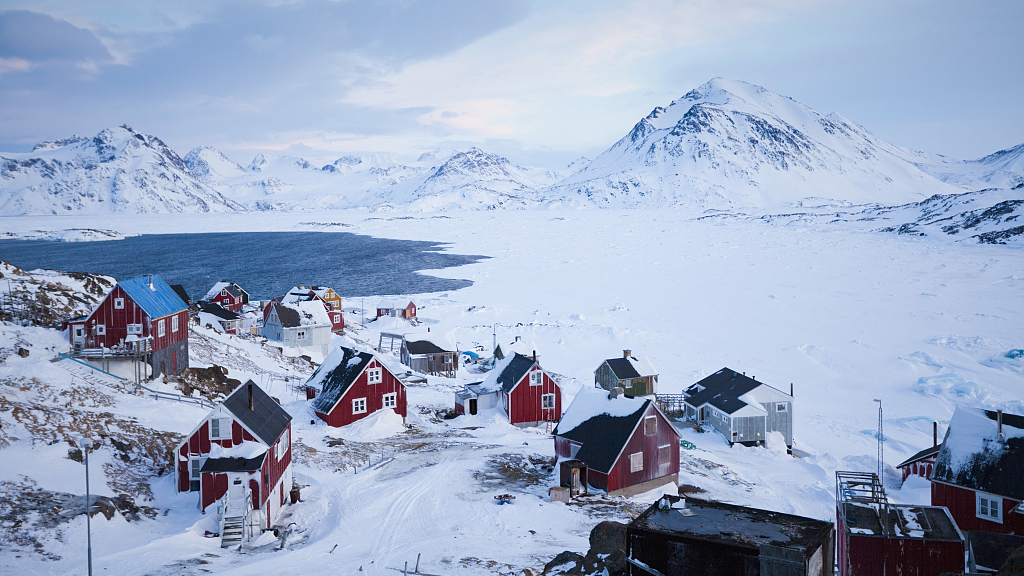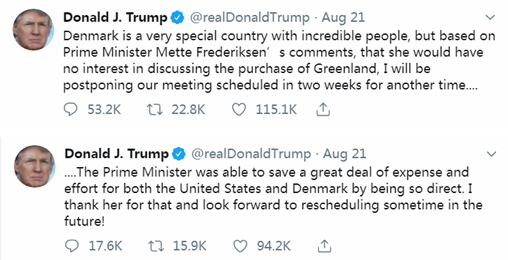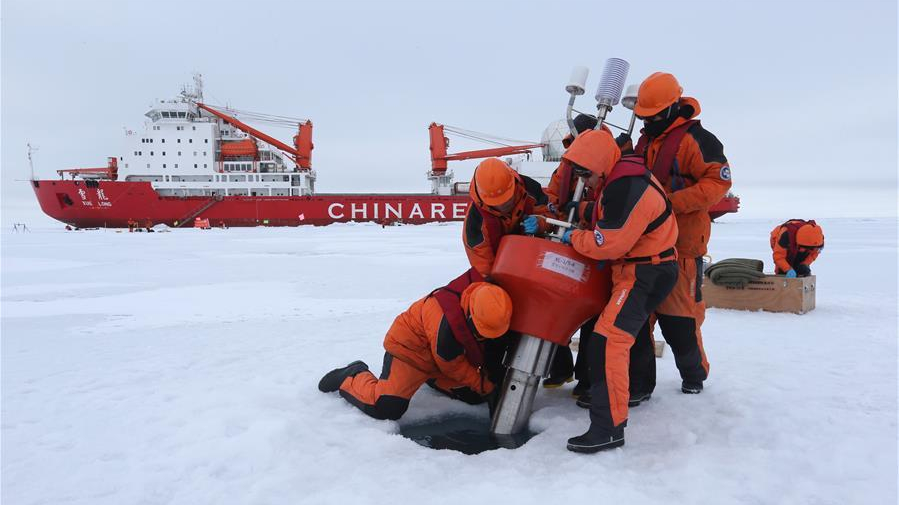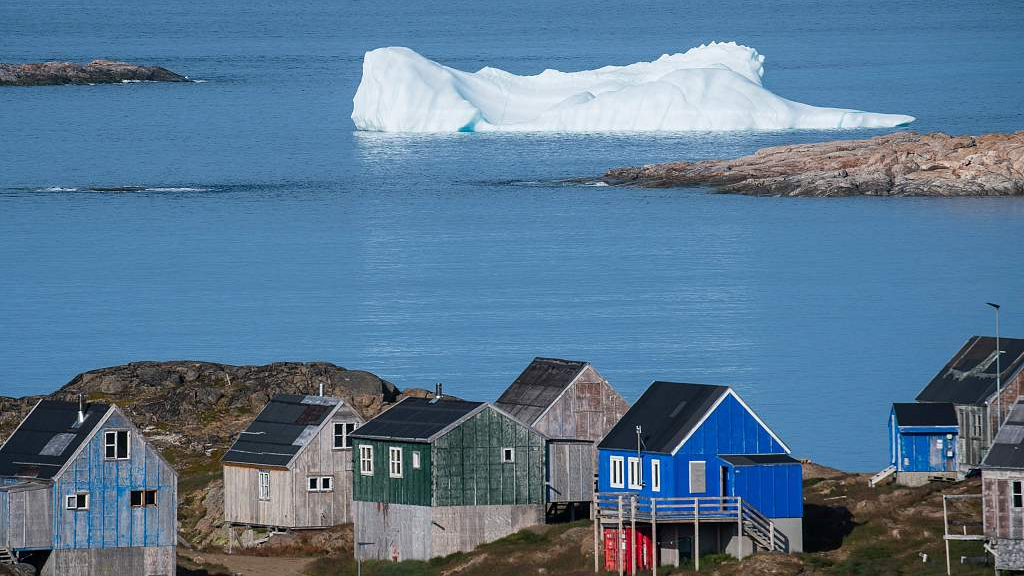

A file photo of northwest Greenland. /VCG Photo
U.S. President Donald Trump's unsolicited bid to buy Greenland – a semi-autonomous territory of Denmark located between the North Atlantic and Arctic oceans – has sparked a diplomatic row between Washington and Copenhagen after Danish Prime Minister Mette Frederiksen snubbed the proposal as "an absurd discussion."
Peeved by Frederiksen's rejection, Trump canceled a scheduled visit to Denmark while launching a war of words with the Danish leader, even calling her remarks "nasty."
While the Danish government has insisted that the island of 55,000 inhabitants is "not for sale," the U.S. president's piqued reaction only confirmed how serious he has been about purchasing Greenland, an idea that was initially being dismissed as a joke by many.

Screenshots of U.S. President Donald Trump's tweets. /CGTN Photo
So, what exactly are the reasons behind Trump's interest in one of the world's most desolate places?
Analysts suggest that securing the world's largest island might be the "deal of a lifetime" for Trump, a former real estate magnate, and give him a place in the history books along with former presidents Thomas Jefferson, who purchased Louisiana from the French in 1803 nearly doubling the country's territory, and Andrew Johnson, who bought Alaska from the Russian Empire in 1867.
Others, however, felt that besides seeking personal glory the U.S. president is also guided by strategic considerations in the resource-rich Arctic with an aim to counter Chinese and Russian influence in the region.
Greenland's resources, particularly its rare earth minerals, make it a lucrative choice for the U.S. which is heavily dependent of foreign supplies of rare earth metals, with 80 percent of its current imports coming from China.
Battle for the Arctic

Members of China's research team set up an ocean-profiling float at a short-term data acquisition location near the icebreaker Xuelong, or "Snow Dragon," in the Arctic Ocean, August 18, 2016. /Xinhua Photo
Related story: China proposes building 'Polar Silk Road' in Arctic
Read also: The Arctic: A cold territory heats up
Greenland has been a base for American military resources for years and the U.S. State Department expressed interest in the island as far back as 1867. Also in 1946, President Harry S. Truman offered 100 million U.S. dollars in gold, or parts of Alaska, in exchange for Greenland, as revealed in a 1991 report by The Associated Press.
The melting polar ice sheet due to global warming is opening up potentially major shipping routes in the Arctic region, which may make it easy to access untapped reserves of oil, gas and minerals in the near future. This has led to increased interest in the Arctic by global players including the U.S., Russia and China.
China, in its first white paper on Arctic policy published last year, proposed to build a "Polar Silk Road" in the Arctic region as part of its Belt and Road Initiative. Describing China as an "important stakeholder" in the Arctic, considering its proximity to the region, the document also underscored that Beijing has shared interests with Arctic states and a shared future with the rest of the world concerning the Arctic.
Russia, which is one of eight member countries of the Arctic Council, which also includes Canada, Denmark, Finland, Iceland, Norway, Sweden and the U.S., has strategic interests in the region too. In line with its history of exploration and production in the Far North, Russia has been steadily stepping up its presence in the Arctic.
Russia and China are increasingly collaborating on exploring energy resources in the area. In 2017, Russia and China agreed to cooperate on the Arctic's Northern Sea Route.
Mikaa Mered, professor of polar geopolitics at Paris' ILERI Institute of International Relations, opined that Trump's offer to buy Greenland is part of a broader strategic battle being waged over the control of the Arctic. It is a signal to Arctic nations and China, which has shown interest in the region, he told AFP.
"When it comes to the Russians, [Trump's] logic is to say: 'You won't always be the main power in the Arctic even if you are the chair of the Arctic Council in 2021.' And when it comes to the Chinese, the idea is... 'We won't let you get a foothold in Greenland,'" Mered said.
The polar geopolitics expert said the U.S. has already increased its presence by re-establishing a consulate in Greenland's capital Nuuk, and helping to finance new airports, education and social programs. "The end goal is not to acquire Greenland per se but at least some new territory, some new pieces of land," he said.
Rare earth minerals

Icebergs float behind the town of Kulusuk in Greenland, August 16, 2019. /VCG Photo
Related story: Graphics: Why all eyes are on China's rare earths
Read also: Rare earth minerals new front in China-U.S. tariff dispute
A major factor for Trump's keenness for Greenland appears to be its large deposits of rare earth minerals, including neodymium, praseodymium, dysprosium and terbium, along with uranium and the byproducts of zinc.
China leads the global production of these rare earths, a cluster of 17 metals hard to commercialize but essential for high-tech applications, including electric vehicles, wind turbines and military technology. China accounts for more than 70 percent of mined rare earths, and an even higher percentage of processed minerals.
However, the escalating trade war between the world's two largest economies has raised the prospects of Beijing restricting rare earth metals export to the United States.
Washington has already initiated wider efforts to secure alternative supplies, including an increase in domestic production of rare earths, while reducing dependence on China. Earlier this year, the U.S. signed a memorandum to cooperate with Greenland on rare earth mining with an aim to promote investment in the sector.
Greenland is estimated to hold 38.5 million tons of rare earth oxides, while total reserves for the rest of the world stand at 120 million tons.
A target for the U.S. is Greenland Minerals, an Australian company that has generated a good deal of excitement since it started operating on Greenland's southwest peninsula in 2007 to develop the Kvanefjeld mine, which is home to many rare earth metals, The Guardian reported.
More than 100 million tons of ore are believed to be sitting below the surface and the project is expected to become one of the largest global producers outside China, it added.
The Australian firm's largest shareholder is Chinese rare earth producer Shenghe Resources with a holding of 11 percent.
"The United States and China approaches the region in similar ways focusing on access to resources and transit to markets. This means the two great powers are aligned in their interests to be a part of the New North, but it also creates a clear competition between them on who gets access to what," stated a University of Copenhagen policy paper on the geopolitics of Greenland, published in 2013.
In conclusion, Trump's seemingly outlandish bid to buy Greenland appears to be driven in part by the impulse to contain China’s overwhelming dominance in rare earth metals and also by the strategic desire to block Russia's increasing presence in the Arctic.
(With input from agencies)

Copyright © 2018 CGTN. Beijing ICP prepared NO.16065310-3
Copyright © 2018 CGTN. Beijing ICP prepared NO.16065310-3